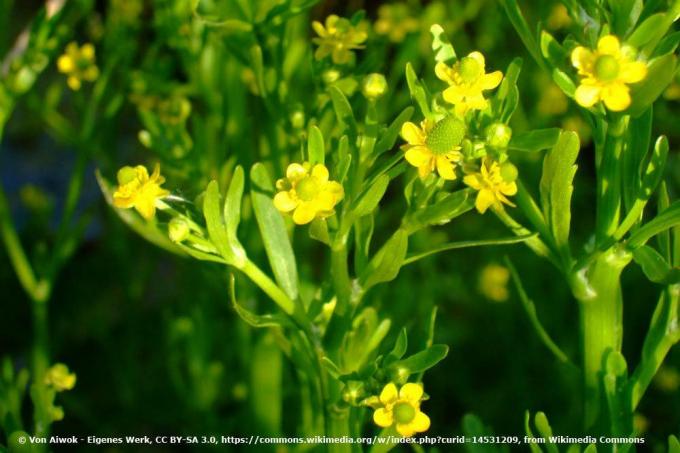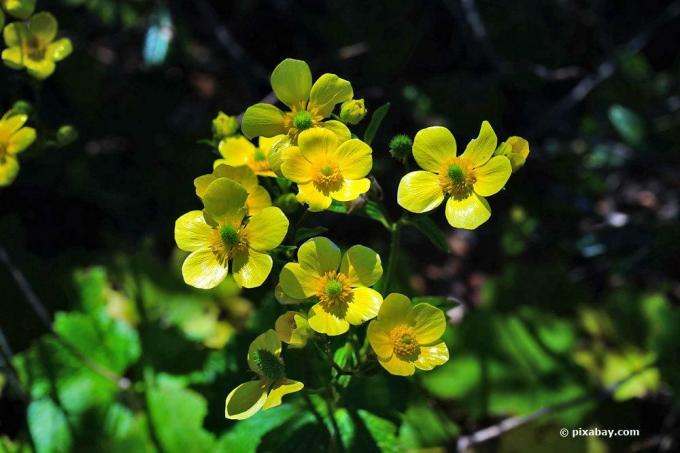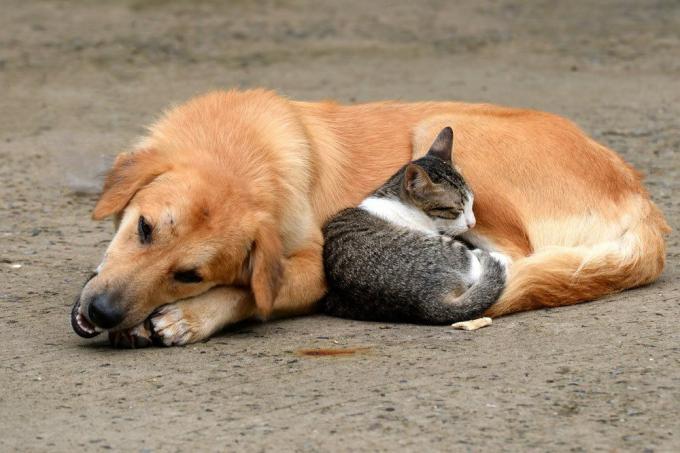
table of contents
- Poison buttercup
- Appearance
- Toxin
- Poisonous plant parts
- Toxicity to humans and animals
- Symptoms
- First aid
- Plant removal
The buttercup with the botanical name Ranunculus sceleratus is not called the poison buttercup for nothing. But above all it is known by the term "buttercup". The wild-growing plant tempts to touch and pick because of its attractiveness. But how dangerous it really is for humans and animals and which symptoms can occur, you will find out in this article.
Poison buttercup
Appearance
So that you know what kind of plant it is, which is known as a poisonous buttercup, you should be able to recognize it.

Optical details
- Basal leaves
- Alternate leaves on the stem
- In the upper area they grow narrow-elliptical or elongated-lanceolate
- Serrated basal leaves are mainly three-parted and long-stalked
- Golden yellow, hermaphrodite flowers with a diameter between one and 2.5 centimeters
- the petals shimmer slightly
- They reach a height of between 30 and 100 centimeters
Typical properties
- Grows predominantly on damp meadows, on the edges of fields, on ponds and streams as well as on compacted lawns
- Blooms from May to September
- Follicles or nuts form between July and October
High risk of confusion
The Ranunculus sceleratus is similar to many other buttercups. This makes clear identification difficult. However, since most of them are also poisonous, you should be careful with all species. In particular, the following buttercups could possibly be mistaken for the one mentioned here. However, their toxicity is no less dangerous:
- Burning buttercup
- Bulbous buttercup
- Sharp buttercup
Toxin
It is the sap that makes the so-called Protoanemonin contains. This is a toxin that, under certain conditions, can even have a fatal effect even if it is only slightly absorbed. The prerequisites are extensive consumption of poisonous plant parts or smaller, more susceptible organisms. With the protoanemonin, nature has created a protection against eating by hamsters, guinea pigs, rabbits, dogs, cats, but also horses and cows. The protoanemonin acts on the central nervous system.
Poisonous plant parts
The buttercup plant is toxic to all parts of the plant. The toxin content is particularly high at the roots. Whether flowers, leaves, stems or even parts of roots, symptoms of poisoning can occur on contact and especially after consumption.
Dried buttercup
If the buttercup has dried out, there is no risk of poisoning. The sap decreases as it dries and is no longer present when it is completely dry. Nevertheless, when tearing off green fodder for a rabbit or other animal, there should not be too much dried buttercups available. There is still a remaining doubt as to whether a small part of the dried parts of the plant could still be slightly poisonous.
Toxicity to humans and animals
Buttercups can cause symptoms of poisoning in humans and animals. Small children and animals in particular are exposed to a high risk of contact and can potentially have serious health consequences. Eating just a few seeds can be fatal.
Symptoms
Skin contact
In adults, the body usually reacts to skin contact with the sap less strong than with small children or smaller pets such as dogs, cats, Guinea pig. Otherwise the picture is identical, which shows as signs of intoxication as follows:
- itching
- Redness of the skin
- Formation of skin vesicles (buttercup dermatitis)
- Skin inflammation
- Burning feeling
Consumption of plant parts
While no life-threatening consequences are to be expected in the event of skin contact, the situation is different when consuming buttercup. Children, senior citizens and small animals in particular are particularly at risk because their immune system against the plant poison is much more difficult than that of a healthy, strong adult. the Symptoms can be noticeable as follows:
- Burning sensation in the mouth
- Blistering in the mouth
- Stomach and abdominal pain
- Vomit
- diarrhea
- Body aches
- dizziness
- Balance disorders
- Signs of paralysis
- Breathing becomes difficult and can even lead to respiratory failure
- Cardiovascular problems - in the worst case up to cardiac arrest
Additional signs in animals
- Continuous panting
- Foaming in the mouth
- Strong thirst
- No longer reacts to being spoken to
- At an advanced stage: drowsiness and no longer wanting to get up
- Horses, cows, sheep: colic
- Heavy breathing
First aid
First aid in case of skin contact
If skin contact with a Ranunculus sceleratus is suspected or has actually taken place, then this is Immediately remove the contact point on the skin, ideally with a neutral soap under lukewarm water to wash off. This should also be done on animals.
In any case, you should avoid getting the sap into your mouth. If it is not known in the case of small children and animals whether this has already happened, a doctor / veterinarian should be contacted or consulted immediately.
First aid when consuming buttercup
doctor
If the amount of the consumed toxin is unknown and / or it concerns children, the elderly or Pets, inform a doctor / veterinarian immediately.
No milk
It is often said that milk is an optimal first aid for poisoning. The opposite is the case, however, since milk promotes / accelerates the absorption of toxins into the blood.
Charcoal tablets
Charcoal tablets reduce the intestinal activity and thicken the intestinal contents, so that the plant poison has less effect on the bloodstream and thus on the central nervous system.
Do not induce vomiting
Under no circumstances should you induce vomiting. Because, especially in children, this can lead to serious health problems in addition to poisoning.
In adult people
As an adult, if you have only got a minimal amount of the poison in your mouth, rinse it out vigorously. Reactions such as burning mouth or nausea with vomiting or diarrhea can definitely occur. But there is no danger to life. Still, you should see a doctor to treat the side effects.
prevention
Plant removal
Look out for buttercups in your garden, especially the venomous buttercup, if you have children or pets. If the plant has "nested" in your garden, remove it immediately. It shouldn't end up on the compost or just in the trash. Burning is the best way to make sure children and animals don't get to the poisonous plant.
Grazing animals like horses or cows usually rely on instinct and avoid buttercups. But the distance is also recommended here. If a willow has been eaten bare or mowed briefly, it still happens that grazing animals eat the poisonous plant.
Avoid contact
Avoid any contact with the Ranunculus sceleratus. To remove, tall gloves and careful handling of the plant are advisable. After pulling out, make sure that no parts of the plant remain. All are to be removed. Care should be taken in particular when removing flowering buttercups. You could lose seeds that not only multiply but are also poisonous.
Note: Please note that this article does not in any way replace a visit to the doctor. There is no guarantee that medical statements are correct.
You will find detailed information on first aid in the event of poisoning and important information on poison control centers here.



